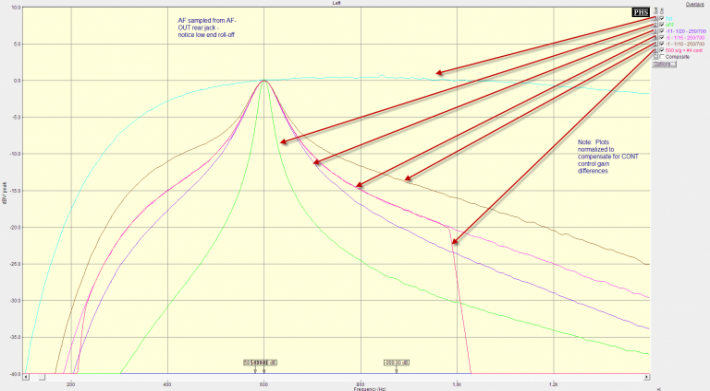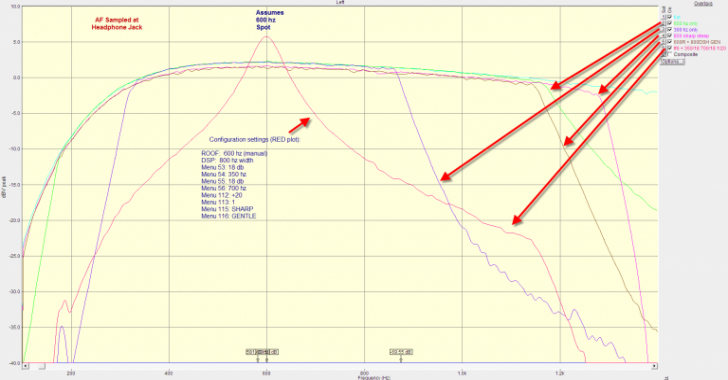Quick Characterization Notes The AF note of the 5K for the CW operator is a fleeting characteristic. Many parts of the system are involved - the op's ear, the speaker (or headphone), the rig jack the AF is taken from, and a lot of the rig control settings. All combine to give the operator a lot of adjustablility. Unfortunately, there are no characterization details provided for the various controls. What I am looking for today is to find a set of control combinations that would provide a reasonable alternative to the missing low-Q APF made so enjoyable in the 2K/9K series. [Interesting comment about the Q of the APF... In looking on the 'inet for comments regarding the APF implementation, most tend to suggest the linear implementation on the 1K-MP was ideal (Q around 30). And that's what the rig offers now, less the gain unfortunately. However, there is also a large fan base for the APF as implemented in the 2K/9K (Q about 10). Both Elecraft and Icom have variations of the APF feature and the users there are just as mixed as we Yaesu guys are.] I was looking for a general consensus as to what's best - and found there is NO consensus. The rig was fed with a 40m S9 crystal signal source. AF was sampled using the shack PC into an AF spectrum analyzer. Rig firmware is based on the 6/20/2011 versions 5.33+1.18. Contour EffectsThe first test was made to determine what the various combinations of Contour settings did. Graph below. AF was sampled from the AF-OUT jack on the rig's back - notice the low end roll off (it's less pronounced with the headphone jacks output). Several combinations of Contour and LPF/HPF rig menu settings are adjusted in the curves shown in the graph. Note 600 Hz spot frequency is assumed here. Menu settings adjusted included: Menu 53: 250 hz Menu 54: 18 db Menu 55: 700 hz Menu 56: 18 db Menu 112: Varied from +10, +15, +20 Menu 113: 1 Used alone, the Contour peaking capability is not gain-adjusted. Which means enabling the Contour command pushes the AF level very far up (+20 db in the extreme case). However, as can be seen in the graphs, the best selectivity occurs with the highest Contour gain settings. Fortunately, the LPF/HPF AF filters strongly impact the entire passband and not only the corner frequency and beyond settings. So with some adjustment of the menu settings 53-56, a very nice overall compromise can be found. The APF effect is in GREEN color for reference. As explained on the prior web page HERE, APF for the CW Op, the APF as currently implemented is a special purpose tool rather than a general purpose CW listening enhancement as was the APF on the earlier 2K/9K. [Special purpose means the signal is already very closely tuned to the ideal, the QRN is low - or the signal is strong, and the sending speed is not too much above about 25 wpm if the signal is weak or the QRN is strong.] But the roofing filter selection plays a role and I wanted to consider that as well before trying to finalize a set of numbers to use for further listening tests. Click the graph for a high-resolution version... 
Roofing and DSP Filter Effects Shown here are a variety of the sweep signal AF responses to the 300 and 600 hz filters. The AF was taken from the headphone jack in this case - and we can see the low end has a bit less of the roll off vs. the AF-OUT jack. Ideally, the DSP and the roofing filter should be of approximately the same overall passband width . Yaesu allows adjustment of the DSP filter settings but unfortunately, they have fixed the width at which the roofing filters are engaged. The filter DSP passband width can vary quite radically. In the 500 hz width case, for example, the soft/gentle combination measures about 770 hz wide, down to about 600 hz with the sharp/steep combination of DSP menu adjustments. Of course, the absolute bandwidth does not matter much - only the width relative to the QRM on the band. After considerable adjustment, I found what seem to be an excellent combination of settings for general band conditions. As well as the resulting plot. The bandwidth is roughly similar to the 2K/9K with the APF enabled. The specific menu settings for the RED plot were: ======================= ROOF: 600 hz (manual, optional use AUTO setting - see below) DSP: 800 hz width Menu 53: 350 hz Menu 54: 18 db Menu 55: 700 hz Menu 56: 18 db Menu 112: +20 Menu 113: 1 Menu 115: SHARP Menu 116: GENTLE ======================= Try these settings, and adjust the LPF/HPF cutoff point (Menu 53 + 55) to your preference. I found that Menu 53=500 and Menu 55=900 were perhaps a bit more symmetrical to the ear and made tuning to zero beat by ear a bit more easy. The graphs on the page are linear vs. frequency and of course, the ear is a log responding instrument and I think it's for that reason a slightly different set of LPF/HPF values sounded better. The setting combination provides a bit of gain as well - much needed with the speaker output especially on a quiet band with very weak signals. The proposed combination does call for MANUALLY setting the roof to 600 hz. However, this could be left in the AUTO setting in which case the 3 KHz filter would be invoked. And when QRM and crowded band conditions call for more selectivity, engaging a 500 hz or less filter bandwidth would pull in the 600/300 hz filters as needed. Try the settings and let me know what you think!. Click the graph for a high-resolution version... 
ConclusionMicrosoft is often criticized for removing features as they progress from one version to the next - and the reason is that some users adopt the feature and like it as it's initially implemented. As is the case with the 2K. I think it's fine for Yaesu to have offered the APF in a high-Q version. But they have given the users who found the old Q=10 style very helpful no choice. Another very poor choice of the similar type was the arbitrary limitation of the minimum DSP filter bandwidth in the WIDE setting. For a contest oriented radio, reducing the number of buttons needed should be a good thing - and we have stepped back from that ideal in the 5K... With the adjustments outlined here, a reasonable work-around to the shortcomings of the high-Q APF is presented. And because there are so many variables in operator, band condition and signal, some experimentation with the specific settings is encouraged. The graphs provided here provide some insight into the effects of the signal from a spectrum standpoint. |